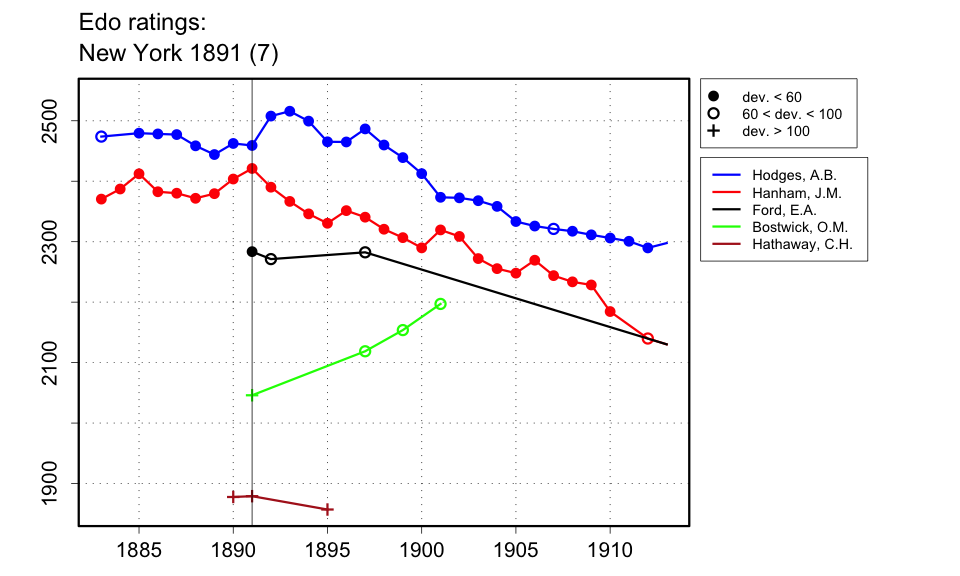| Results |
| |
| Crosstable scores |
|
|
| |
| Odds for class difference of 1: the move |
| Odds for class difference of 2: pawn and move |
| Odds for class difference of 3: pawn and move |
| Odds for class difference of 4: pawn and two moves |
| Odds for class difference of 5: pawn and two moves |
| Odds for class difference of 6: a knight |
| Odds for class difference of 7: a knight |
| |
Event table notes
|
| Event data |
| Name: Manhattan Club Handicap Tournament |
| Place: New York |
| Start date: Oct. 1891 |
| End date: Dec. 1891 |
| |
| Notes: |
| Only partial results available. This was an all-play-all handicap tournament. Hilbert and Lahde give final scores for only the top 5 finishers, indicating that there is some uncertainty about the scores. Different sources give different scores for some of the players, and the total number of games played seems to have varied a bit between players (between 27 and 30 or 31). I have assumed a 31-player tournament, with a full score consisting of 30 games, so that players with scores adding up to less than 30 games did not play 1 or more player at the bottom of the list. Hilbert and Lahde cite the Brooklyn Standard-Union of 2 Jan. 1892, which says that there were 24 entrants, but this does not correspond with the score totals. Hodges scored +27-0=2; Sweeny scored either +23-7=1 or +22-7=1 (I take the latter); Ford scored either +21-7=1 or +21-7=2 (I take the latter); Bostwick scored +16-8=3 and Hanham +18=10=1 (but they apparently tied for 4th and 5th place, so perhaps Bostwick's score is wrong?). The Charleston Sunday News of 27 Dec. 1891 has in addition +16-9=2 for Hathway. There was a class 1A and a class 1B, and Hilbert and Lahde surmise that odds of the move were given between these classes. Presumably, between full classes, the odds sequence went Pawn and Move, Pawn and Two Moves, and the Knight, though I am only guessing at this as the usual procedure. Because my rating program is still limited in how it handles odds classes, I've got 8 classes instead of 5, so that 1A and 1B can be assigned odds of only the move. |
|
| |
| References |
| Books |
| Hilbert and Lahde, Albert Beauregard Hodges, page 98, 99, 102 |
| Periodicals |
| [CSN], 27 Dec. 1891 |
| [NYTr], 27 Dec. 1891 |
| |


